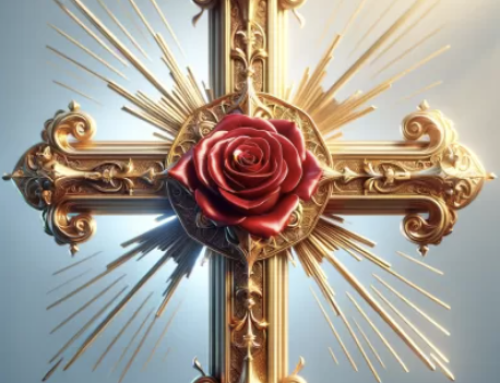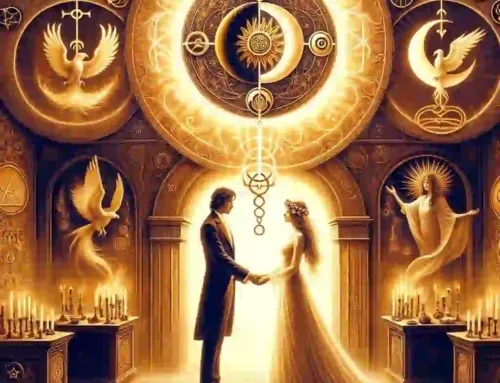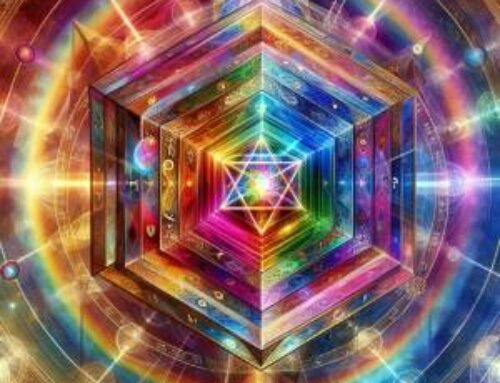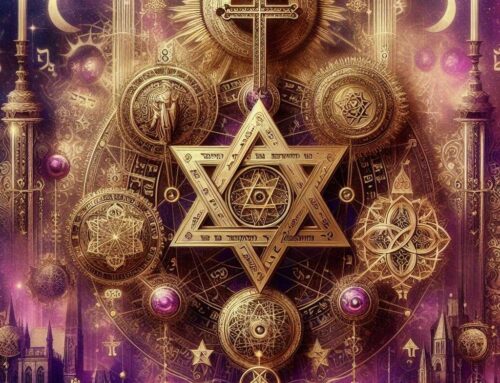Contents
- 1 Introduction
- 2 Spiritual Significance of Rosicrucian Symbols Within Hermetic Traditions
- 3 The Rose Cross: Rosicrucian Symbols of Spiritual Awakening
- 4 How the 7 Hermetic Axioms Illuminate the Understanding of Rosicrucian Symbols
- 4.1 1. The Principle of Mentalism: “The All is Mind”
- 4.2 2. The Principle of Correspondence: “As above, so below; as below, so above”
- 4.3 3. The Principle of Vibration: “Nothing rests; everything moves; everything vibrates”
- 4.4 4. The Principle of Polarity: “Everything is dual; everything has poles; everything has its pair of opposites”
- 4.5 5. The Principle of Rhythm: “Everything flows, out and in; everything has its tides”
- 4.6 6. The Principle of Cause and Effect: “Every Cause has its Effect; every Effect has its Cause”
- 4.7 7. The Principle of Gender: “Gender is in everything; everything has its masculine and feminine principles”
- 5 The Role of Alchemical Symbols in Depicting the Rosicrucian Path Towards Spiritual Gold
- 6 The Interconnectedness of Tarot Imagery with Rosicrucian Spiritual Teachings and the Journey of the Soul
- 7 Conclusion
- 8 FAQ – Rosicrucian Symbols
- 8.1 1. What is the significance of the Rose Cross in Rosicrucianism?
- 8.2 2. How do Hermetic principles relate to Rosicrucian symbols?
- 8.3 3. Can the Tarot really guide one on the path to enlightenment?
- 8.4 4. What role does alchemy play in Rosicrucian symbolism?
- 8.5 5. How can I start exploring Rosicrucian symbols and their meanings?
- 9 References:
Introduction
Rosicrucian symbols stand as beacons of profound mystical wisdom, transcending mere historical artifacts to become living guides on the spiritual journey. Rooted in the rich soil of hermetic traditions, these Rosicrucian symbols offer more than just insight into an esoteric order; they serve as universal keys to unlocking the deeper mysteries of the soul and the cosmos. The Rose Cross, alchemical motifs, and the intricate tapestry of the Tarot’s imagery are not merely symbols but are imbued with the essence of spiritual transformation, guiding seekers on the path towards enlightenment.
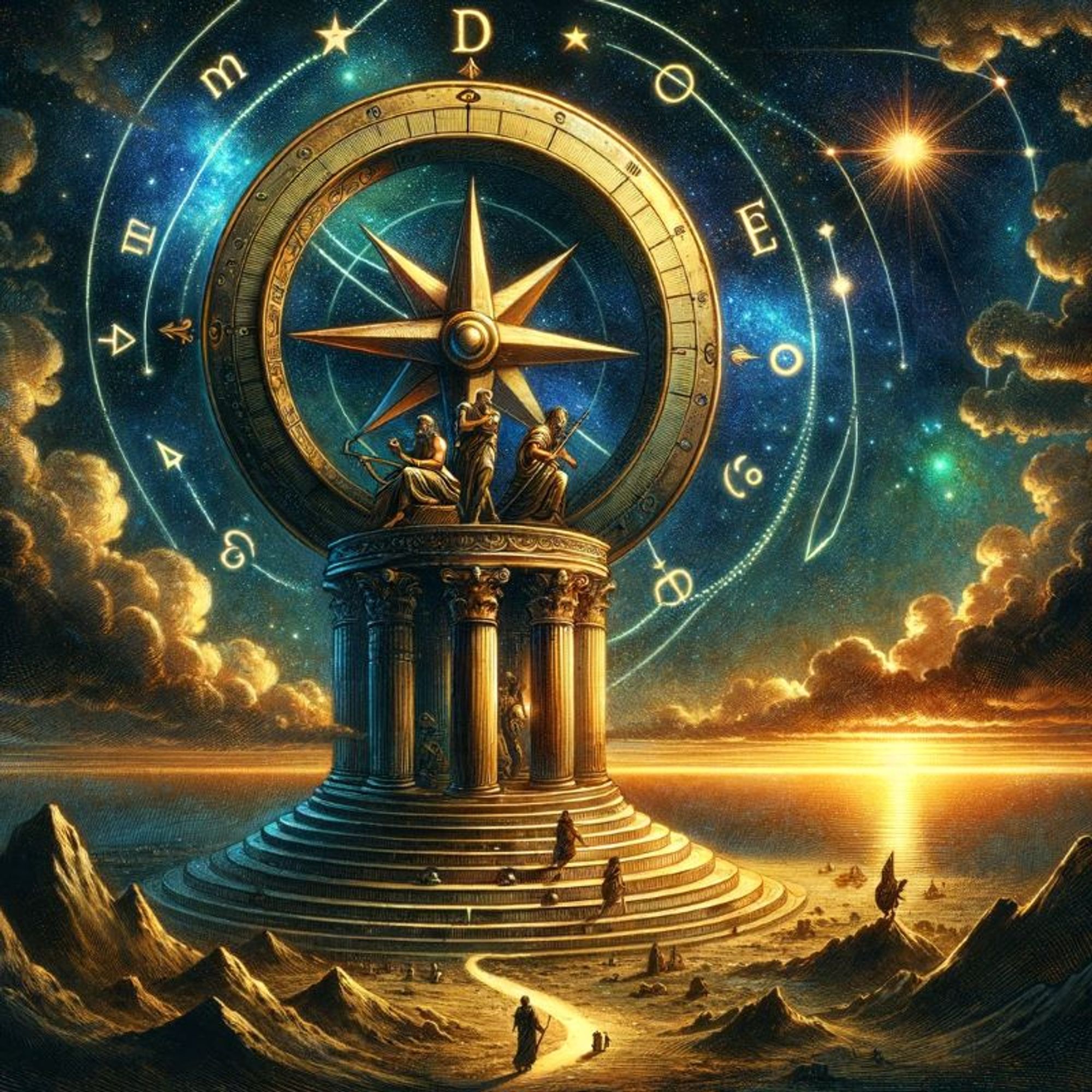
Within the heart of Rosicrucian symbols lies the core philosophy of spiritual alchemy—the transmutation of the soul from leaden earthly existence to the golden state of divine awareness. This journey, encapsulated in symbols, mirrors the hermetic axiom “As above, so below,” suggesting that the macrocosm of the universe reflects the microcosm of the individual soul. It is through understanding and integrating these Rosicrucian symbols that one can embark on a transformative journey, navigating the trials and tribulations of the material world to uncover the luminous essence of the spirit within.
As we delve deeper into the meanings behind Rosicrucian symbols, we embark on a quest not just of intellectual discovery but of personal and spiritual awakening, where each symbol serves as a milestone on the eternal path of the soul’s evolution towards its highest potential.
Spiritual Significance of Rosicrucian Symbols Within Hermetic Traditions
The Rosicrucian tradition, steeped in mystery and rich with ancient wisdom, offers a unique lens through which to explore the spiritual journey. At the heart of this mystical path lie the Rosicrucian symbols, each a vessel of deep esoteric truths and a beacon for those seeking enlightenment. These symbols, far more than mere illustrations, are keys to unlocking the profound spiritual significance embedded within hermetic traditions. They serve as guides, leading the seeker through the intricate landscape of the soul’s evolution towards its ultimate destination: union with the Divine.
Historical Genesis and Evolution
The origins of Rosicrucian symbols trace back to the crossroads of ancient civilizations, where the streams of Hermeticism, Christian mysticism, and alchemical knowledge merged. These symbols evolved over centuries, encapsulating the wisdom of mystics, alchemists, and philosophers. They embody the Rosicrucian ethos of seeking knowledge to transform both the self and the world. As we delve into the history of these symbols, we uncover a tapestry of human striving for understanding and transcendence, reflecting the evolution of spiritual thought through the ages.
Symbolic Layers and Interpretations
Each of these Rosicrucian symbols is a multidimensional matrix of meanings, offering layers of interpretation that reveal the interconnectedness of the universe, the dual nature of existence, and the pathway to spiritual awakening. The Rose Cross, the most emblematic of these symbols, illustrates the journey of the soul through the crucible of life, its suffering, and its eventual blooming into spiritual enlightenment. This and other symbols serve as metaphysical maps, charting the course from material bondage to the liberation of the spirit.
The Symbols as Conduits of Esoteric Knowledge
Rosicrucian symbols are not static; they are dynamic conduits of esoteric knowledge and spiritual power. They act as focal points for meditation, gateways to higher consciousness, and tools for transforming the psyche. Engaging with these symbols, the seeker embarks on an inner alchemy, where the base elements of the self are transmuted into the gold of spiritual wisdom. This process is reflective of the hermetic principle “As above, so below,” highlighting the microcosm within the macrocosm and the divine spark within the human.
Archetypes can be understood as culturally determined symbolic forms, organizing and structuring non-cognitive mental aspects of human life, rather than biologically inherited predispositions (1).
Practical Application in Spiritual Practices
Beyond their theoretical significance, Rosicrucian symbols find practical application in the spiritual practices of the tradition. They are integrated into rituals, ceremonies, and meditative practices designed to attune the individual’s consciousness to higher dimensions of reality. Through these practices, the symbols become living experiences, pathways through which seekers encounter the mysteries of existence and their own place within the cosmic order.
The Enduring Relevance of Rosicrucian Symbols
In the contemporary quest for meaning and spiritual depth, Rosicrucian symbols remain as relevant as ever. They offer a timeless wisdom that transcends cultural and historical boundaries, addressing the universal human longing for understanding, transformation, and connection with the divine. As we explore the essence of these symbols, we are invited into a living tradition that continues to inspire and guide individuals on their spiritual journeys, providing a compass for navigating the complexities of the modern world with ancient wisdom.
The Rose Cross: Rosicrucian Symbols of Spiritual Awakening
Origins and Historical Context of the Rose Cross
The Rose Cross, an emblem of profound spiritual significance, serves as a cornerstone within the Rosicrucian tradition. Its genesis is as mystical as the Rosicrucian symbols itself, with roots deeply entrenched in early Christian mysticism, medieval alchemy, and the esoteric wisdom of the ages. This symbol, often depicted as a cross adorned with a single rose at its center, transcends mere religious iconography to embody the universal principles of transformation and enlightenment.
The historical journey of the Rose Cross traces back to the ancient practices of mystics and alchemists who sought not only the transmutation of base metals into gold but also the spiritual alchemy of the soul. In the tapestry of Christian mysticism, the cross represents the trials and tribulations of the material world, while the rose symbolizes the awakening and unfolding of the soul’s inherent divine nature. Together, they illustrate the pathway to spiritual rebirth and enlightenment, a theme that resonates with the core teachings of Rosicrucianism.
Symbolic Interpretations of the Rose Cross
Delving deeper into the symbolism of the Rose Cross reveals layers of meaning that illuminate the Rosicrucian path. The cross, an ancient symbol of the earth and the physical body, anchors the spirit in the material plane, reminding the seeker of their earthly journey through suffering and transformation. The rose, with its delicate petals unfolding, represents the awakening of spiritual consciousness, the blooming of inner wisdom, and the unfolding of the soul’s potential.
The Rose Cross in Alchemical Imagery
Alchemical imagery, rich with symbols of transformation and transmutation, often features the Rose Cross as a central emblem of the alchemist’s quest. This imagery highlights the alchemical process of turning leaden human experiences into spiritual gold, mirroring the inner work required on the path to enlightenment. The Rose Cross stands as a beacon, guiding the alchemist through the stages of dissolution, purification, and ultimately, the realization of the Philosophers’ Stone – the Rosicrucian symbols of ultimate spiritual achievement (2).
The Rose Cross and the Modern Seeker
In the contemporary spiritual landscape, the Rose Cross continues to serve as a powerful tool for meditation and reflection. It beckons the modern seeker to embark on their own journey of self-discovery and transformation. By meditating on the symbol and embracing its teachings, one can unlock the doors to deeper spiritual insights, personal growth, and a greater understanding of the cosmos and one’s place within it.
How the 7 Hermetic Axioms Illuminate the Understanding of Rosicrucian Symbols
The intersection of Hermeticism with Rosicrucianism marks a profound confluence of wisdom traditions, where the timeless Hermetic axioms serve as foundational pillars for the rich tapestry of Rosicrucian symbols. These axioms, encapsulated in the legendary Emerald Tablet, offer universal truths that transcend time and culture, providing key insights into the nature of reality, the cosmos, and the human spirit. Through the lens of the 7 Hermetic principles, we gain a deeper understanding of the symbols that form the core of Rosicrucian spiritual practice and philosophy.
1. The Principle of Mentalism: “The All is Mind”
The first Hermetic axiom, “The All is Mind,” posits that the universe is fundamentally mental in nature. This principle illuminates the Rosicrucian symbols, especially the Rose Cross, as manifestations of the divine mind, reminding us that our reality is shaped by our perceptions, beliefs, and thoughts. This principle encourages the seeker to cultivate a consciousness attuned to the higher vibrations of wisdom and understanding.
2. The Principle of Correspondence: “As above, so below; as below, so above”
This principle highlights the interconnectedness of the universe, asserting that the macrocosm is reflected in the microcosm. Rosicrucian symbols, laden with celestial and terrestrial imagery, embody this axiom, guiding the practitioner in the exploration of the outer cosmos to understand the inner realms of the soul, and vice versa, revealing the unity of all existence.
3. The Principle of Vibration: “Nothing rests; everything moves; everything vibrates”
The Hermetic axiom of vibration underlines the dynamic nature of the universe. Rosicrucian symbols, vibrating with spiritual energy, teach the importance of harmonizing with the cosmic frequencies. Understanding this principle allows the seeker to navigate through various states of consciousness, facilitating spiritual awakening and growth.
4. The Principle of Polarity: “Everything is dual; everything has poles; everything has its pair of opposites”
The duality represented in Rosicrucian symbols, such as light and darkness, life and death, reflects this Hermetic principle. It teaches the adept to transcend polarities, finding balance and unity in the apparent opposites, and recognizing that opposites are merely two extremes of the same continuum.
5. The Principle of Rhythm: “Everything flows, out and in; everything has its tides”
This axiom speaks to the cyclic nature of the universe. Rosicrucianism embraces this principle through Rosicrucian symbols that depict cycles of birth, death, and rebirth, reminding us that we are part of a larger cosmic rhythm. By attuning to this flow, the seeker learns to navigate life’s changes with grace and understanding.
6. The Principle of Cause and Effect: “Every Cause has its Effect; every Effect has its Cause”
In Rosicrucianism, the understanding that nothing happens by chance is central. Rosicrucian symbols that depict sowing and reaping, or action and consequence, emphasize the importance of intentional living and spiritual responsibility, encouraging seekers to be mindful of the seeds they plant in the garden of their lives.
7. The Principle of Gender: “Gender is in everything; everything has its masculine and feminine principles”
This principle is reflected in Rosicrucian symbols that encompass the balance of masculine and feminine energies, such as the intertwining of the rose and cross. It underscores the necessity of harmonizing these energies within the self as part of the spiritual path to wholeness and integration.
The Role of Alchemical Symbols in Depicting the Rosicrucian Path Towards Spiritual Gold
The mystical path of Rosicrucianism is deeply entwined with the ancient art of alchemy, a tradition rich in symbols and metaphors that map the transformative journey of the soul. Alchemical symbolism, far beyond its literal quest for turning base metals into gold, offers profound insights into the Rosicrucian pursuit of spiritual enlightenment. This sacred alchemical process, symbolized through enigmatic and powerful imagery, serves as a metaphor for the internal transformation required to attain spiritual gold, the ultimate realization of divine consciousness.
The Alchemical Process: A Metaphor for Transformation
At the heart of alchemical practice lies the Great Work (Magnum Opus), a series of processes symbolizing the purification and perfection of the practitioner’s inner being. The stages of this work—nigredo (blackening), albedo (whitening), citrinitas (yellowing), and rubedo (reddening)—are mirrored in the Rosicrucian path, each representing crucial phases in the seeker’s spiritual evolution. Alchemical symbols associated with these stages, such as the black crow, white swan, yellow lion, and red phoenix, depict the journey from spiritual darkness to the awakening of the light within, culminating in the rebirth of the soul.
The Philosophers’ Stone: Symbol of Ultimate Achievement
The Philosophers’ Stone, a legendary substance capable of turning base metals into gold and granting eternal life, stands as the pinnacle of alchemical and Rosicrucian symbols. This elusive Stone symbolizes the Rosicrucian quest for spiritual enlightenment—a transformation so profound that it transcends physical bounds, leading to the realization of the self’s divine nature. It represents the essence of the Great Work: the alchemical transmutation of the lower self into the Higher Self, the true gold of spiritual awakening.
The Vessel of Transformation: The Alembic
The alembic, a piece of alchemical apparatus used for distillation, symbolizes the containment and transformation of the practitioner’s spirit. Just as substances are heated and purified within the alembic, so too are the seeker’s base qualities refined through the fires of spiritual practice. This symbol illustrates the Rosicrucian emphasis on the inner laboratory, where the work of self-reflection, meditation, and contemplation leads to the distillation of spiritual wisdom.
The Marriage of the Sun and Moon: The Coniunctio
The alchemical motif of the coniunctio, or the sacred marriage between the Sun (Sol) and the Moon (Luna), represents the union of opposites within the practitioner’s being. This symbolic marriage of the masculine and feminine, the rational and the intuitive, mirrors the Rosicrucian pursuit of balance and integration. The resulting harmony from this inner alchemy opens the heart to the light of consciousness, illuminating the path to enlightenment.
From Lead to Gold: The Journey of the Soul
The alchemist’s goal of turning lead into gold serves as a powerful allegory for the Rosicrucian path of spiritual transformation. Lead, symbolizing the soul’s unrefined, base nature, is gradually transmuted into gold, the symbol of divine illumination and purity. This journey from darkness to light, from ignorance to wisdom, encapsulates the essence of the Rosicrucian and alchemical quest for enlightenment.
The two-factor Enlightenment Scale, At Peace and Open-Heartted, effectively measures the experience of enlightenment, allowing for more efficient and effective assessment of individuals’ enlightened states (3).
The Interconnectedness of Tarot Imagery with Rosicrucian Spiritual Teachings and the Journey of the Soul
The Tarot, a collection of cards rich in Rosicrucian symbols, serves as a profound tool for divination, reflection, and spiritual insight. Its intricate tapestry of archetypes and symbols offers a mirror to the soul, reflecting the multifaceted journey of human consciousness. Within the Rosicrucian tradition, the Tarot’s esoteric wisdom finds a harmonious resonance, its imagery and teachings deeply intertwined with the mystical path of Rosicrucian enlightenment. This interconnectedness reveals a shared quest for understanding the mysteries of existence and the soul’s evolution towards its divine origin.
Tarot Imagery as a Reflection of Rosicrucian symbols
The Tarot deck, particularly the Major Arcana, encapsulates core themes and principles found in Rosicrucian wisdom. Cards such as The Magician, The High Priestess, and The Hermit resonate with the Rosicrucian pursuit of knowledge, intuition, and inner illumination. These archetypes embody the stages of spiritual awakening and the inner work required on the path of self-discovery. Through meditation and contemplation on the Tarot’s symbols, Rosicrucian adepts navigate the complex interplay of the material and spiritual realms, seeking to harmonize their lives with the universal laws.
The Fool’s Journey: A Parallel to the Rosicrucian Path
The narrative arc of the Major Arcana, often referred to as “The Fool’s Journey,” parallels the Rosicrucian initiate’s spiritual voyage. The Fool, representing the soul at the beginning of its journey, encounters various trials, lessons, and revelations, symbolized by the subsequent cards. This allegorical journey mirrors the Rosicrucian path of evolution from ignorance to enlightenment, where each stage of spiritual development is marked by challenges, growth, and deeper understanding. The Tarot thus becomes a tool for reflection, offering insights into the soul’s progress and the cyclical nature of spiritual growth.
The Tarot’s Symbology and Hermetic Principles
The Tarot is imbued with symbols that reflect the Hermetic principles central to Rosicrucian philosophy. Cards such as The Wheel of Fortune and Justice illustrate the principles of rhythm and cause and effect, respectively, reminding the seeker of the dynamic balance of the cosmos and the importance of ethical conduct. The symbiosis between Tarot imagery and Hermetic wisdom enriches the Rosicrucian’s contemplative practices, providing a visual and intuitive means to grasp the profound truths underlying existence.
The Tarot’s Role in Unveiling Universal Truths
The Tarot, with its rich lexicon of Rosicrucian symbols, acts as a key to unlocking the universal truths that underpin the Rosicrucian path. Each card, a repository of ancient wisdom, invites the seeker to explore the depths of their being and the cosmos. Through the practice of the Tarot’s teachings, Rosicrucian adepts gain insights into the nature of reality, the interconnectedness of all life, and the soul’s eternal journey towards enlightenment.
Conclusion
Rosicrucian symbols, rich in ancient wisdom and spiritual depth, offer a compelling journey into the heart of mystical tradition. From the profound symbology of the Rose Cross to the intricate teachings of the Tarot, these symbols serve as guides on the seeker’s path towards enlightenment. They invite us to explore the mysteries of existence, to transform ourselves through the alchemical process, and to align with the Hermetic principles that underpin the cosmos.
As we navigate through the complexities of the modern world, the timeless wisdom of Rosicrucian symbols remains a beacon of light, leading us towards a deeper understanding of ourselves and our place in the universe. These symbols are not just relics of a mystical past but are living keys to unlocking personal and spiritual growth.
An Invitation to Explore the Mysteries of Rosicrucianism
We invite you to delve deeper into the mysteries of Rosicrucian (4) symbols. Whether through initiation, contemplation, or meditation, there is a wealth of spiritual insight waiting to be discovered. Join us on this journey of transformation and enlightenment. Explore our resources, participate in our online retreats, and become part of a community dedicated to spiritual evolution and growth. Together, let us unlock the mystical alphabet of the soul.
FAQ – Rosicrucian Symbols
1. What is the significance of the Rose Cross in Rosicrucianism?
The Rose Cross is a central symbol in Rosicrucianism that represents the harmonious blend of earthly experiences and spiritual awakening. It signifies the journey of the soul through trials towards the blooming of spiritual consciousness.
2. How do Hermetic principles relate to Rosicrucian symbols?
Hermetic principles, such as “As above, so below,” provide a foundational philosophy for understanding Rosicrucian symbols. They underscore the interconnectedness of the universe and the individual, guiding the interpretation of symbols towards insights on the microcosm and macrocosm.
3. Can the Tarot really guide one on the path to enlightenment?
A: Yes, the Tarot, especially when integrated with Rosicrucian wisdom, can be a powerful tool for reflection, self-awareness, and understanding the spiritual journey. Its archetypal imagery and symbols offer deep insights into the journey of the soul and the universal challenges and triumphs it faces.
4. What role does alchemy play in Rosicrucian symbolism?
A: Alchemy plays a significant role in Rosicrucian symbols as a metaphor for the transformation of the soul. Alchemical symbols within Rosicrucianism depict the stages of spiritual purification and enlightenment, echoing the quest for the Philosophers’ Stone or the attainment of spiritual gold.
5. How can I start exploring Rosicrucian symbols and their meanings?
A: Exploring Rosicrucian symbols and their meanings deeply is possible through enrollment in an authentic mystery school like the Hermetic Academy, where sacred and secret teachings are unveiled. This dedicated environment provides structured courses, initiations and a community for profound spiritual growth and understanding.
References:
(1) Pietikainen, P. (1998). Archetypes as symbolic forms. Journal of Analytical Psychology, 43, 325-343. https://doi.org/10.1111/1465-5922.00032.
(2) Rubenstein, E. (2023). Alchemy: Secrets of Consciousness Transformation. Hermetic World, Paphos.
(3) Boyd-Wilson, B., & Walkey, F. (2015). The Enlightenment Scale: A Measure of Being at Peace and Open-Hearted. Pastoral Psychology, 64, 311-325. https://doi.org/10.1007/S11089-013-0586-9.
(4) Rubenstein, E. (2023). Magic: The Legacy of the Rosicrucians. Hermetic World, Paphos.

